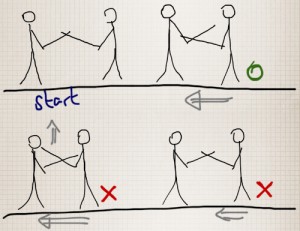Class was started in the usual fashion, with stretching, running and suburi. In hayasuburi, Heeren-sensei admonished some of the kenshi for not bringing the shinai back against the buttocks in every single suburi round, as it is a helping hand in figuring if your swings are going down the center line.
The first ten to fifteen minutes of the day’s lesson were fully spent on explanation. The crowd gathered around Heeren-sensei and Kiwa-sempai who demonstrated a number of things.
- When striking, also in suburi, stretch your left arm. A lot of people are still using a crooked arm which is costing them in reach.
- In kirikaeshi and in your strikes, always do the upswing properly through the center. This has been discussed before.
- When striking, Heeren-sensei imagines the kensen to be his finger nail. When striking, his shinai replaces his index finger, as he points out the targets in question. Point at kote, then in tenouchi jerk with left to strike. Point at men, then in tenouchi jerk with left and strike. Etc. But be careful to not make a “stroking” strike!
- This analogy should also prevent you from raising your shinai too far upwards. Raise your shinai too far and it will be completely visible to your opponent who will thus be clued in on what you’re doing.
- In what I’ve come to call the ‘Heeren kote-men Special’, Heeren-sensei suggested a technique to use in shiai and keiko where one strikes kote on the inside as opposed to the outside. The goal is not to strike kote, the goal is to both startle your opponent and to use the spring of his hands/shinai to speed up the men strike. Men is the goal.
They also took a lot of time explaining the physical aspects of seme to men (“pressure and men”). An excellent read on seme would be Stephen Quinlan’s “The fundamental theorem of kendo?“.
In this particular exercise we would be stepping in deep, so deep as to almost pierce our opponents navel. While stepping in, our shinai would go through the center (do not push your opponent’s shinai aside), thus sliding on top or over the opponent’s shinai. Our kensen will be held low, as to disappear from our op’s view. From this position, we would proceed to strike oki-men. The rough sketches above show this: step in deep, not just a little bit and keep the kensen low, not high.
It was pointed out that the seme movements we had been practicing do not only serve a big role in shiai and jigeiko, but that they are also very useful in uchikomi keiko. This was demonstrated by Kiwa-sempai who repeatedly got very close to Heeren-sensei before striking the designated targets.
De les begon op gebruikelijke wijze met rekken, hard lopen en suburi. Na de ronde hayasuburi was Heeren-sensei ontevreden over het feit dat een aantal kenshi hun shinai niet volledig naar achteren brachten. De tik op je billen is bedoeld voor jezelf om te controleren of je zwaai netjes door het midden gaat; gebruik hem dan ook!
Het eerste kwartier van de les werd besteed aan tekst en uitleg. Heeren-sensei en Kiwa-sempai demonstreerden een aantal zaken.
- Als je slaat, ook in suburi, strek dan je linker arm. Veel mensen houden hun arm nog steeds te veel gebogen, wat je enorm veel reikwijdte kost.
- Tijdens kirikaeshi en in al je andere slagen, moet je door het midden omhoog zwaaien. Dit is eerder uitgelegd en besproken.
- Heeren-sensei beeldt zich bij een slag in dat de kensen zijn nagel is en de shinai zijn wijsvinger is. Hij wijst de doelwitten denkbeeldig aan. Wijs kote aan en maak je slag met tenouchi. Wijs men aan en maak je slag met tenouchi. Enz. Maar pas op dat je niet gaat “aaien”.
- Deze analogie kan ook helpen voorkomen dat je je shinai te ver optilt. Onthoud: als je je shinai te ver tilt ziet je tegenstander hem beter en zal hij ook door kunnen hebben wat je gaat doen.
- Heeren-sensei demonstreerde een techniek die hij in shiai en jigeiko gebruikt: men slaat kote-men via de binnenkant in plaats van de buitenkant. Het doel is niet om ippon op kote te maken, maar op men. Je slaat op de handen van je tegenstander om hem te laten schrikken en om de veerkracht van zijn handen te gebruiken om sneller op men te slaan.
Men demonstreerde ons ook de fysieke aspecten van seme to men (“druk en men”). Een uitermate leerzaam document over seme is Stephen Quinlan’s “The fundamental theorem of kendo?“.
Bij deze oefening stappen we zeer diep in, zo diep dat we bijna in de navel van motodachi steken. Je houdt de shinai in het midden (duw motodachi‘s shinai niet aan de kant), waardoor hij bovenop de shinai van de ander glijdt. Je beheerst nu zijn shinai. Je kensen verdwijnt nu ook uit zijn gezichtsgebied, waardoor hij minder goed kan zien wat je gaat doen. Tijdens de oefening deden we vanuit deze diepe positie oki-men. De schetsen laten deze beweging zien: stap zeer diep in, niet maar een klein stukje en houdt de kensen laag, niet hoog.
Men maakte ook het punt dat deze seme beweging niet alleen in shiai en jigeiko wordt gebruikt, maar ook goed kan worden toegepast in uchikomi geiko. Dit werd gedemonstreerd door Kiwa-sempai die herhaaldelijk zeer dichtbij Heeren-sensei kwam voordat zij haar slagen maakte.

